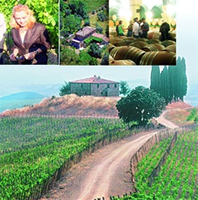Tuscany, a great wine tourism destination, uncorks a fine experience for those who like to mix their whites and reds with history, writes Leher Kala, a journalist who recently visited Montalcino and the nearby Siena towns in Tuscany
 The Italians will tell you the Tuscan way is easygoing and relaxed; where you can revel in the summer sun that sets after 10 at night. Where the valley, full of undulating hills, changes colours with the sun from yellow to golden, finally settling down to a magnificent orange. The Italians will tell you the Tuscan way is easygoing and relaxed; where you can revel in the summer sun that sets after 10 at night. Where the valley, full of undulating hills, changes colours with the sun from yellow to golden, finally settling down to a magnificent orange.
The Medieval Montalcino
Few regions reflect the languid atmosphere of Tuscany better than Montalcino, a quaint medieval town, two hours by road from Rome, that's shot into prominence recently as a popular destination for wine tourists. Montalcino is home to over 250 families who have been making wine, some since the 19th century. The Indian Wine Academy organised a trip for Indian writers and buyers to Montalcino, to sample their most famous wines and experience first hand, the painstaking process of wine making.
We stayed in El Brunello, a charming little hotel about five kilometers from the main town (150 Euros a night), with a terrific view of the vineyards. The next morning we headed for our first wine tasting experience in Montalcino; almost a hundred bottles of the region's best wines were arranged in a row with glasses and spittoons. Michele Shah, a wine consultant based in Italy and the organiser of the trip, warned us novices to spit it out. "Roll it around in your mouth then let it go," she advised. Those of us who didn't had a nasty hangover by the afternoon.
Biondi Santi
Our first winery visit began with a trip to Biondi Santi, Montalcino's best-known wine estate. The current owner, Franco Biondi Santi, well into his 80s, comes from a family of winegrowers and has a formidable cellar, with wines dating from 1888 carefully preserved in temperature controlled rooms. "These bottles have survived two World Wars," he stated. Santi's wine is aged in Slavonian oak barrels, some of which are over a hundred years old. His estate is spread over 150 hectares with a rambling Tuscan bungalow within surrounded by flowers and cypress trees that Santi rents out periodically. When we asked him about the traditional pairing of red wine with red meat, and white wine with fish, Santi smiled and replied in broken English, "It's about what suits your palate. These days you can make your own rules."
Italy has a distinguished wine heritage that goes back more than 2,000 years. Almost every region of Italy produces wine and dedicated drinkers have discovered touring rural Italy is a terrific way to sample wines you're unlikely to find back home. Montalcino is on every wine tourist's map. This province combines history, art, beautiful estates and superb vintages to give the traveler a complete holiday.
Our second winery visit was to Fattorio Dei Barbi, a wine estate that traces its origins way back to 1352. The current owner Promozione is a chirpy, 40-something who also runs an excellent restaurant on the premises. It serves dishes made with pecorino cheese processed on the estate itself. He gave us a guided tour of the Museum on his property that stocks primitive wine bottle openers and other ancient artifacts.
Italian Hospitality
The Italians are wonderfully hospitable. Throughout these wine tastings that are open to everyone with just a single phone call, they go all out to make this an unforgettable experience. Typically, four glasses per person are arranged on a long table, usually, with the estate owner himself pouring out the wine and explaining its characteristics, history and ageing techniques. The wines are paired with personally selected, home-cooked Tuscan food, made with locally produced olive oils and vinegars. While visiting Castelli Martinozzi, another famous winery, the owner Cesare Castelli proudly showed us his six bottles of wine from 1927. "We had many more but the Gestapo drank them in the 1940s," he told us ruefully. His estate is now handled by his daughter's son, a qualified oenologist.
Between the wine excursions, tourists to Montalcino should take a detour to the main town, the Piazza del Popolo, situated downhill from the town's famous fortress. If you're looking for nightlife, this town has little to offer; however, there is one pub in the main town.
Detour at Siena
Siena, the picturesque city, a World Heritage Site is barely 40 miles away. Its cathedral, the Duomo that dates to the 12th century is a fantastic example of Roman architecture. Shopping is prohibitively expensive throughout, though Italy is a brand watchers delight. However, the Brunello and Rosso wines on sale throughout the area are certainly worth spending on. ...
Leher Kala is Senior Assistant Editor (Features) journalist with Indian Express Group. The article first appeared in Indian Express. She was a part of the delegation of 14 buyers and journalists organised by the Indian Wine Academy. Leher may be contacted at leherkala@gmail.com - editor |